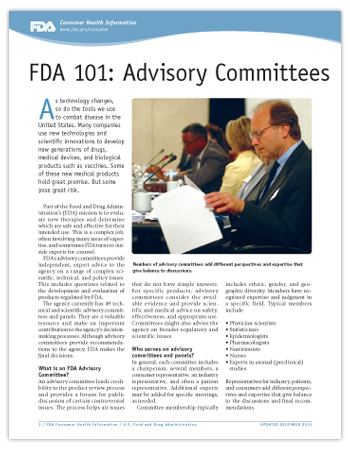For Consumers
FDA 101: Advisory Committees
Printer-friendly PDF (272 KB) |
 Get Consumer Updates by E-mail
Get Consumer Updates by E-mail
As technology changes, so do the tools we use to combat disease in the United States. Many companies use new technologies and scientific innovations to develop new generations of drugs, medical devices, and biological products such as vaccines. Some of these new medical products hold great promise. But some pose great risk.
Part of the Food and Drug Administration’s (FDA) mission is to evaluate new therapies and determine which are safe and effective for their intended use. This is a complex job, often involving many areas of expertise, and sometimes FDA turns to outside experts for counsel.
FDA's advisory committees provide independent, expert advice to the agency on a range of complex scientific, technical, and policy issues. This includes questions related to the development and evaluation of products regulated by FDA. The agency currently has 48 technical and scientific advisory committees and panels. They are a valuable resource and make an important contribution to the agency’s decision-making processes. Although advisory committees provide recommendations to the agency, FDA makes the final decisions.
What is an FDA advisory committee?
An advisory committee lends credibility to the product review process and provides a forum for public discussion of certain controversial issues. The process helps air issues that do not have simple answers. For specific products, advisory committees consider the available evidence and provide scientific and medical advice on safety, effectiveness, and appropriate use. Committees might also advise the agency on broader regulatory and scientific issues.
Who serves on advisory committees and panels?
In general, each committee includes a chairperson, several members, a consumer representative, an industry representative, and often a patient representative. Additional experts may be added for specific meetings, as needed.
Committee membership typically includes ethnic, gender, and geographic diversity. Members have recognized expertise and judgment in a specific field. Typical members include
- Physician-scientists
- Statisticians
- Epidemiologists
- Pharmacologists
- Nutritionists
- Nurses
- Experts in animal (preclinical) studies
Representatives for industry, patients, and consumers add different perspectives and expertise that give balance to the discussions and final recommendations.
What does a consumer representative do?
Consumer representatives are technically qualified professionals who have specific links with consumer advocacy groups or community based organizations.
Consumer representatives
- facilitate dialogue with the committees on scientific issues that affect consumers
- must be able to analyze scientific data
- must understand research design
- must discuss benefits and risks
- must evaluate the safety and effectiveness of products under review
How often do advisory committee meetings occur?
Advisory committee meetings can occur during any stage of a product's review process, or if appropriate, once a product is marketed. Typically, an individual committee may convene on average one to four times per year. The decision to involve an advisory committee is usually at the discretion of the Division Director of one of FDA's five product centers.
How does a person become a member of an advisory committee?
Nominations for scientific members and consumer, industry, and patient representatives typically come from professional societies, industry, consumer and patient advocacy groups, the interested individual, or from other interested people. Candidates must be willing to provide detailed information about financial holdings, employment, research grants and contracts, and other potential conflicts of interest. FDA is committed to finding qualified individuals who represent a variety of points of view to serve on advisory committees. Applications are now available on line.
How can the public provide input to the advisory committees?
Each advisory committee meeting includes a comment period during which members of the public; individuals or spokespersons from the regulated industry (except the sponsor whose product is under review); consumer advocacy groups; and professional organizations, societies, or organizations are invited to speak.
The following procedures for the public comment session are set to go into effect in March 2011:
- Before an advisory committee meeting, people may ask—orally or in writing—to speak at the meeting. Each request should include contact information, the topic to be addressed, and the amount of time the speaker is requesting for the comment. FDA usually gives each person 5 to 10 minutes.
- FDA staff members respond to individual requests, and, if the topic is unrelated to the committee’s work, the request may be declined.
- At the meeting, speakers should identify themselves to FDA staff members and provide the staff with any handouts or other materials. The FDA staff will pass these materials on to committee members. These materials will then become part of the meeting’s permanent record.
- FDA will designate a seating area for speakers.
- FDA encourages committee members to question the speakers to find out more information that might be useful in the committee’s deliberations. Committee members and the public should be reminded of the importance of the open public hearing session and that all speakers should be treated with courtesy and respect.
- Public speakers are encouraged to disclose any financial relationships they may have with the topic of the meeting or with the sponsors of competitors of the products under discussion.
- FDA encourages public participation in the public comment sessions as a means of enhancing advisory committee deliberations and FDA’s decision-making processes.
This article appears on FDA's Consumer Updates page, which features the latest updates on FDA-regulated products.
Updated: December 9, 2010








